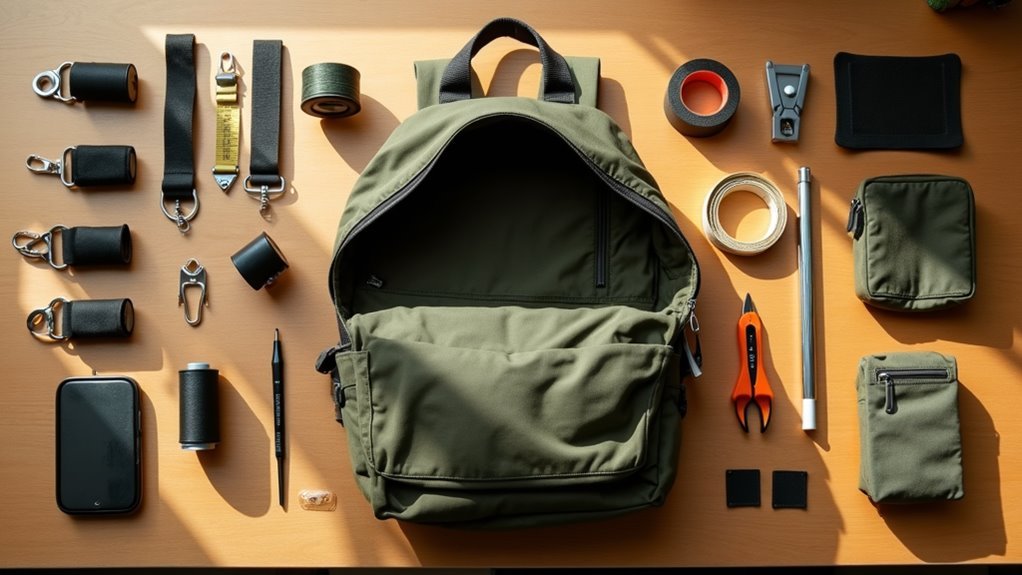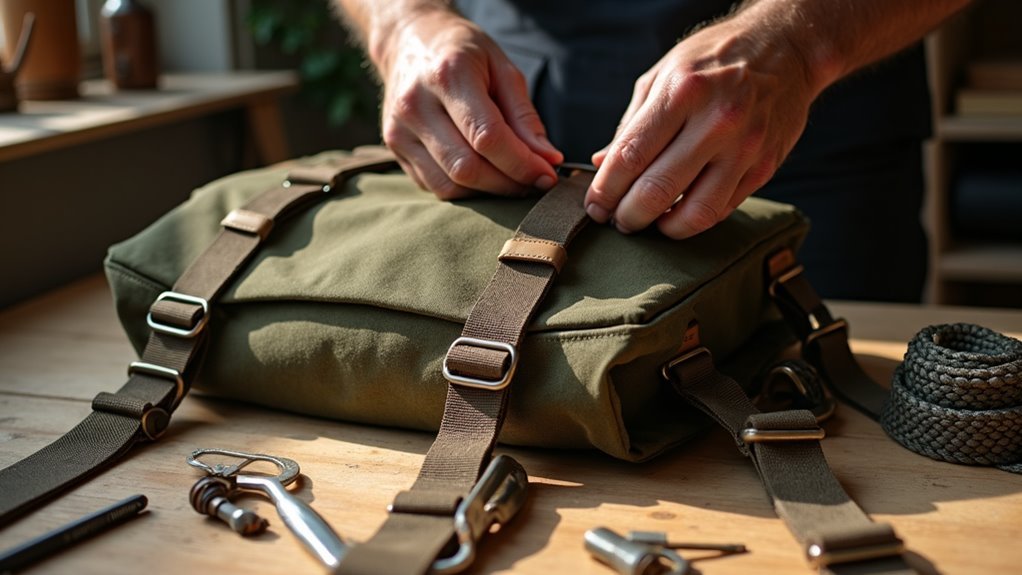I’ll show you how to transform your shoulder bag into a backpack using items you probably already have at home. First, I clear out my bag completely and place the original strap around my neck, positioning the bag at hip level. Then I attach a scarf or shoelace to create a diagonal cross-body strap for weight distribution. After adjusting both straps for comfort and testing the setup, you’ll discover additional techniques that make this conversion even more effective.
Preparing Your Bag and Gathering Materials

Before you start the transformation process, you’ll want to gather the right materials and choose an appropriate bag.
I think single-strap bags work best for this—though I’ve seen people try with multiple handles, it gets messy quickly.
You’ll need something to extend your reach: a scarf, shoelace, or perhaps a proper strap extender.
Clear out everything from your bag first, and I mean everything.
Empty every single pocket, compartment, and hidden corner before beginning—overlooked items will complicate the entire transformation process.
Check those hidden pockets twice.
Set up somewhere with decent space.
The whole process becomes surprisingly quick once you get the hang of it, maybe even seconds.
Positioning and Securing the Original Strap
Once you’ve got your materials ready, the next step involves getting that original strap positioned properly—though I’ll admit this part feels a bit awkward at first.
I start by placing the strap around my neck, almost like putting on a seatbelt. The bag should hang at waist or hip level for balance.
Here’s what I focus on:
- Position the bag so it sits comfortably against your back
- Adjust the strap length to prevent slouching
- Keep the weight centered—perhaps slightly to one side
- Test your range of motion before proceeding
The positioning takes practice, but you’ll get there.
Attaching Additional Straps for Backpack Conversion

With your shoulder bag now positioned correctly, you’ll need to create those all-important second straps that actually make this whole thing work—and honestly, this is where the magic happens.
I typically grab a scarf or shoelace for this step, though any sturdy fabric strip works. Attach one end securely to your bag’s existing strap, then loop it across your chest diagonally.
The key is creating that cross-body support system that distributes weight evenly.
Perhaps you’ll need to adjust the length a few times—I usually do. Make sure both attachment points feel solid before trusting it with your belongings.
Making Final Adjustments for Comfort and Security
Three quick tweaks usually make the difference between a makeshift conversion that feels awkward and one that actually works for your daily routine.
I think the weight distribution needs your attention first. If everything’s sliding to one side, you’ll feel it within minutes. The bag should sit close to your back without pulling you backward.
Weight distribution makes or breaks your comfort—when everything slides sideways, you’ll know immediately something needs adjusting.
- Tighten straps until there’s no bouncing when you walk
- Check that nothing sharp pokes through the fabric into your back
- Test arm movement – you shouldn’t feel restricted reaching forward
- Verify quick access to your phone or keys
Perhaps most importantly, take a few steps around before heading out.
Frequently Asked Questions
Will Converting My Shoulder Bag Void Its Warranty or Damage It Permanently?
I can’t guarantee warranty coverage since manufacturers differ, but this gentle conversion shouldn’t permanently damage your bag. You’re simply repositioning existing straps without cutting or altering the bag’s structure permanently.
Can I Use This Technique With Designer Bags or Expensive Leather Handbags?
Like a bird protecting its precious feathers, I’d approach designer bags cautiously. You can use this technique, but I’d test it first with cheaper bags to master the method before risking your expensive leather investments.
How Much Weight Can a Converted Shoulder Bag-Backpack Safely Carry?
I’d recommend keeping the weight under 10-15 pounds maximum. Your converted bag’s original strap wasn’t designed for backpack loads, so lighter items work best to prevent strap failure or damage.
Is This Conversion Method Suitable for Children or Elderly Users?
Studies show 30% of back injuries stem from improper weight distribution. I’d recommend this conversion for independent-minded children over 8, but elderly users should consider their mobility and balance before attempting this hands-free carrying method.
What Should I Do if the Conversion Fails While I’m Out?
If your conversion fails while you’re out, I’d recommend immediately checking all attachment points for security. You can quickly readjust the strap positioning or temporarily carry it normally until you’re somewhere safe to retry.
Conclusion
You’ve just revealed the secret to never being caught off-guard again. This little transformation trick has honestly saved me more times than I can count – perhaps most memorably during a crowded street festival when juggling snacks became, well, less than graceful. I think you’ll find this method surprisingly sturdy, though I’d recommend testing it with lighter loads first. Your shoulders (and your style) will thank you for this clever workaround.